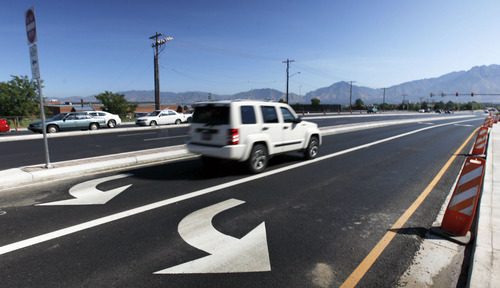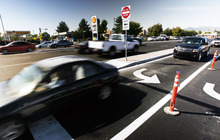This is an archived article that was published on sltrib.com in 2012, and information in the article may be outdated. It is provided only for personal research purposes and may not be reprinted.
Nile Easton says it was his worst moment as a spokesman for the Utah Department of Transportation.
He was on live TV five years ago in front of an unusual, new Continuous Flow Intersection (CFI) at 3500 South and Bangerter Highway saying it was easy to understand and use. Just then behind him, a car crashed on a new median, and the older driver cried out her window, "I don't know where to go."
Despite that rough beginning, UDOT studies now report that funky-design intersection actually has reduced accidents by a surprising 60 percent within three-quarters of a mile around the intersection since it opened in 2007.
"A lot of that is because there's not as much backing up on 3500 South as there used to be. Flowing traffic is generally safer than stop-and-go traffic," says UDOT traffic engineer Robert Miles. "It's improved safety on Bangerter as well, but the improvement wasn't quite as noticeable because the backing wasn't as bad there."
The intersection at 3500 South is the only CFI that has been operating long enough in Utah to produce reliable three-year averages for accident data. UDOT has since built six other CFIs along Bangerter — with another planned next year — plus two on Redwood Road and one on University Parkway in Orem.
UDOT studies also figure that the seven CFIs on Bangerter — between 3100 South and 7000 South — are saving commuters an estimated $6.1 million a year in time and gasoline. They also reduced afternoon commutes by an estimated 3 minutes and 35 seconds daily for drivers using the intersection. And they saved taxpayers hundreds of millions of dollars in construction costs over other congestion-reducing options.
"I don't have buyer's remorse about these," Miles said. "We can't solve the future's problems doing things the way we have in the past. We have to find better solutions, and these are proving themselves."
UDOT turned to CFIs when traffic on crossroads along Bangerter was backing up drastically, leading to long delays, which made many drivers view Bangerter as a sort of Great Wall of China blocking east-west travel across it.
"About 25 percent of the signal cycle was to serve left-turn movements," Miles said. But CFIs eliminate separate left turns off Bangerter, helping provide more time to move traffic in other directions.
Drivers seeking to turn left off Bangerter at CFIs enter special turn lanes well before the main intersection. Signals allow cars to then cross traffic into new extreme far left lanes that will allow turns onto crossroads at the same time that through-traffic on Bangerter proceeds forward.
The design is unusual, and Easton's experience on live TV shows the learning curve can be steep for some motorists. "But I feel like people have really caught on to the concept," Miles said, supported by the 60 percent reduction in accidents at 3500 South. He adds he receives no more reports of silly mishaps by drivers at CFIs than he does at traditional intersections.
One big advantage of CFIs, he said, is they cost $6 million to $8 million on average to build, compared with the $30 million to $40 million for a freeway-like, grade separation interchange. That has saved hundreds of millions of dollars along Bangerter.
Also, CFIs can be built in a more narrow area than a full interchange. That has prevented removing many businesses along the Bangerter corridor. A full interchange at 6200 South, for example, would have required removing an entire large shopping center.
"The economics are such that with a CFI, you can get a lot of the benefits for a fraction of the cost," Miles said. "They are about a fourth of the price of a grade-separation interchange."
He adds that UDOT still uses freeway-like interchanges when they make sense — and just added one at 7800 South and Bangerter. He notes they require more distance between interchanges because of changes in elevation, and they will work better on the southern end of Bangerter where major crossroads are farther apart.
Miles said shortened travel time from CFIs saves motorists an estimated 800,000 gallons of fuel a year.
UDOT is doing a study to reset the timing of signals along Bangerter to take advantage of time savings from the CFIs plus the new 7800 South exchange and the new "diverging diamond" interchange at 2100 South.
"It's a system integration," Miles said. "So I think we'll see even better performance as we go forward."
Adan Carrillo, spokesman for UDOT's Region 2, notes that Utah has embraced CFIs more than any other state — and the 4100 South intersection at Bangerter is the only one in the nation that has CFI movement in all four directions instead of two. —
Impacts of CFI on Bangerter Highway
Time • Typical afternoon commutes in the area are 3 minutes and 35 seconds shorter.
Fuel • The design saves an estimated 800,000 gallons of gasoline annually.
Safety • There's been a 60 percent reduction in accidents within 3/4 mile of the intersection at 3500 South since 2007.
Cost savings • UDOT estimates savings of $6.1 million per year for commuters, with $2.6 million from fuel and $3.5 million from time.
Construction savings • The costs are $6 million to $8 million, compared with $30 million to $40 million for freeway-like interchanges.
Source • Utah Department of Transportation





